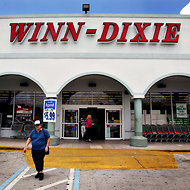 Joe Raedle/Getty ImagesA Winn-Dixie store in Miami in 2004.
Joe Raedle/Getty ImagesA Winn-Dixie store in Miami in 2004.
Bi-Lo agreed on Monday to buy Winn-Dixie Stores for about $560 million, uniting two of the South’s better-known regional supermarket operators.
Under the terms of the deal, the privately held Bi-Lo will pay $9.50 a share in cash, 75 percent more than Winn-Dixie’s closing price on Friday.
The two companies said in a statement that the merger was driven by a desire for greater scale. Bi-Lo’s and Winn-Dixie’s geographic areas have no overlap. Bi-Lo operates 207 stores in South Carolina, North Carolina, Tennessee and Georgia, while Winn-Dixie runs 480 locations in Florida, southern Georgia, Alabama, Mississippi and Louisiana.
“The combined company will have a perfect geographic fit that will create a stronger platform from which to provide our customers great products at a great value, while continuing to offer exceptional service,” R. Randall Onstead Jr., Bi-Lo’s chairman, said in the statement.
Both companies had suffered over the last decade and subsequently filed for bankruptcy protection. Winn-Dixie filed in February 2005 and emerged a year later, having closed down hundreds of locations.
Bi-Lo filed for Chapter 11 protection in 2009 to help address coming debt maturities, and exited a year later. It is still owned by the private equity firm Lone Star Funds.
Both the Bi-Lo and Winn-Dixie brands are expected to live on after the merger, and neither company expects to close any stores. The location of the combined company’s headquarters has not been decided, though it is expected to maintain corporate presences in both Greenville, S.C., Bi-Lo’s home, and Jacksonville, Fla., Winn-Dixie’s base.
The deal is expected to close in the next two or three months, pending approval by Winn-Dixie shareholders.
Bi-Lo was advised by a raft of counselors: William Blair; Citigroup; the Food Partners; Alvarez Marsal’s transaction advisory group; Gibson, Dunn Crutcher; and Hunton Williams.
Winn-Dixie was advised by Goldman Sachs and the law firms King Spalding and Greenberg Traurig, while its special board committee was advised by Paul, Weiss, Rifkind, Wharton Garrison.
Article source: http://feeds.nytimes.com/click.phdo?i=e2d90c95b3d485e122ff37cc5e84e5fa




